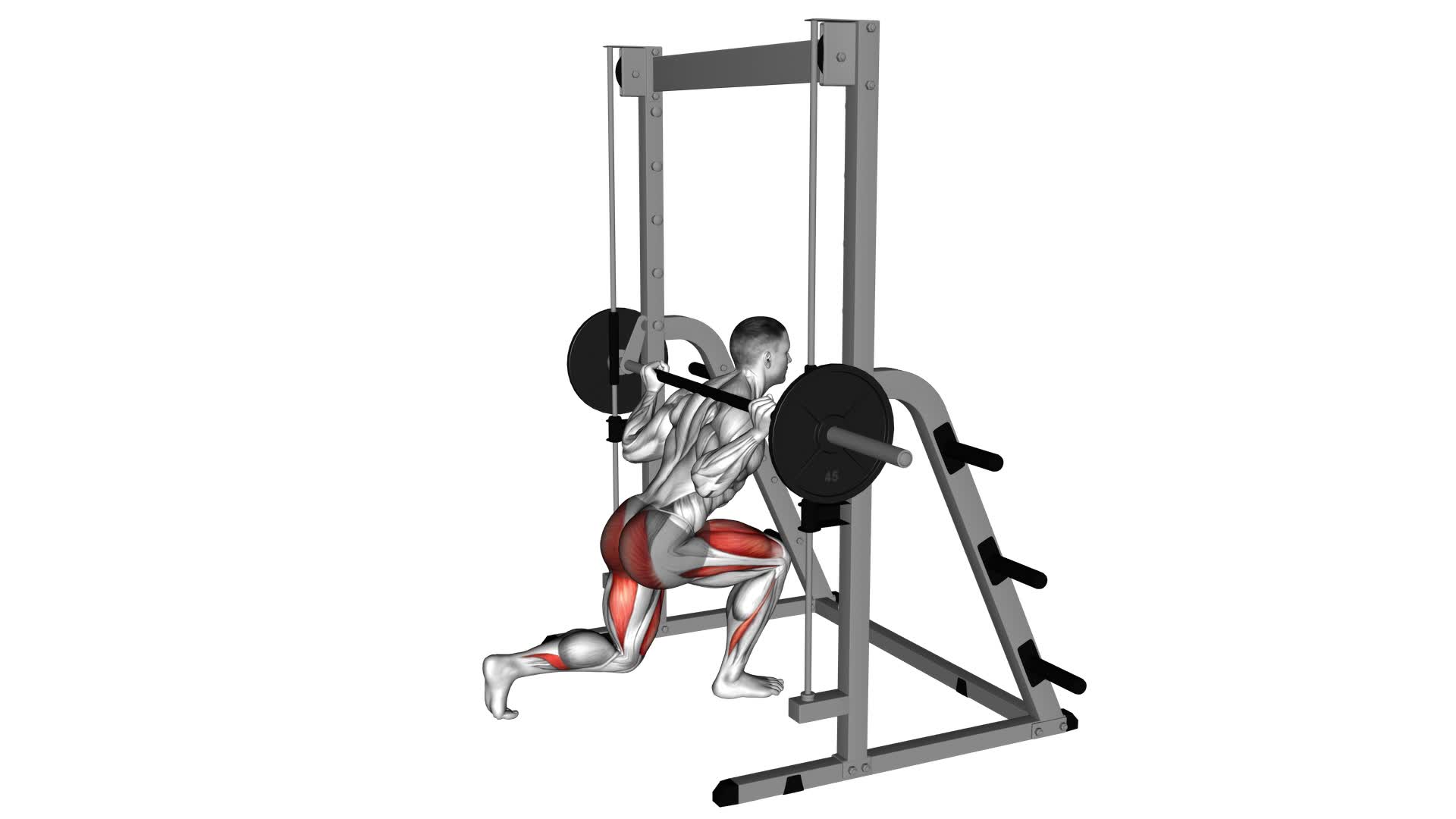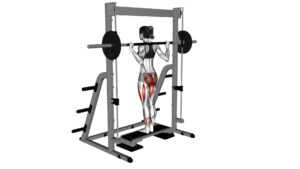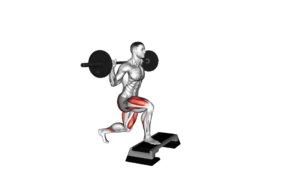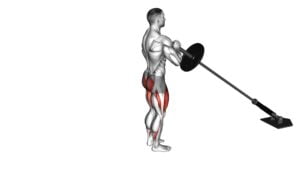Smith Rear Lunge (version 2) (male) – Video Exercise Guide & Tips

Looking to strengthen your lower body?
Watch This Exercise Video
Check out this video exercise guide for the Smith Rear Lunge (version 2) specifically designed for males.
This guide will provide you with step-by-step instructions, common mistakes to avoid, and tips to maximize the effectiveness of this exercise.
Whether you're a beginner or a seasoned gym-goer, this guide will help you achieve your fitness goals.
So grab your equipment and get ready to lunge your way to stronger legs!
Key Takeaways
- Smith Rear Lunge targets multiple muscles in the lower body
- Proper form techniques include maintaining a stable and upright posture, stepping back into the lunge with control, and engaging core, glutes, and quadriceps for muscle activation
- Common mistakes to avoid include improper knee alignment, lack of core engagement and lifted chest, uneven weight distribution between front and back legs, and improper foot positioning and balance
- Modifications and variations include incorporating dumbbells for increased resistance, as well as trying walking lunge and lateral lunge variations.
Benefits of Smith Rear Lunge (version 2) for Males
Discover the benefits of the Smith Rear Lunge (version 2) for males.
The Smith Rear Lunge (version 2) is a highly effective exercise that targets multiple muscles in your lower body, including your quadriceps, hamstrings, and glutes. By incorporating this exercise into your workout routine, you can experience several benefits.
Firstly, the Smith Rear Lunge (version 2) helps improve your lower body strength and stability. The movement engages your leg muscles, forcing them to work together to execute the lunge. This not only increases muscle activation but also enhances overall balance and coordination.
Additionally, this exercise encourages proper breathing techniques. As you perform the lunge, inhale deeply and exhale slowly. Focusing on your breath helps maintain oxygen flow to your muscles, improving endurance and performance.
Furthermore, the Smith Rear Lunge (version 2) can be modified to target specific muscle groups. By adjusting the foot placement or adding dumbbells, you can emphasize certain areas, such as your glutes or hamstrings.
Proper Set-Up and Equipment for Smith Rear Lunge (version 2)
To properly set up and perform the Smith Rear Lunge (version 2), you'll need a Smith machine and a barbell. The Smith machine provides stability and support, making it easier to maintain proper form throughout the exercise. When setting up the machine, ensure that the bar is at a height that allows you to comfortably step under it and have it rest on your shoulders. The bar should be loaded with an appropriate weight for your fitness level.
When it comes to equipment recommendations, it's important to choose a barbell that's suitable for your strength and comfort. The bar should be straight and have a comfortable grip. Additionally, make sure that the collars on the barbell are securely fastened to prevent any accidents or injuries during the exercise.
With the proper set-up and equipment in place, you're ready to move on to the step-by-step guide to performing the Smith Rear Lunge (version 2). This exercise targets your quadriceps, glutes, and hamstrings, helping to build strength and stability in your lower body.
Step-by-Step Guide to Performing Smith Rear Lunge (version 2)
To perform the Smith Rear Lunge (version 2) with proper form, there are a few key techniques to keep in mind. These include:
- Maintaining a stable and upright posture
- Stepping back into the lunge with control
- Keeping your front knee aligned with your toes
It's important to avoid common mistakes such as:
- Leaning too far forward
- Allowing your knee to go past your toes
- Rushing through the movement.
Proper Form Techniques
When performing the Smith Rear Lunge (version 2), it's important to ensure proper form by following these step-by-step guidelines.
First, focus on proper breathing techniques to optimize your performance and reduce the risk of injury. Inhale deeply before starting the movement and exhale as you push back up. This will help stabilize your core and provide the necessary oxygen for your muscles.
Additionally, engage your muscles by using muscle activation techniques. Before lunging, engage your core, glutes, and quadriceps to maintain stability and maximize the effectiveness of the exercise.
By incorporating proper breathing techniques and muscle activation techniques, you'll improve your form and maximize your results.
Now, let's move on to the common mistakes to avoid when performing the Smith Rear Lunge (version 2).
Common Mistakes to Avoid
To avoid common mistakes and perform the Smith Rear Lunge (version 2) effectively, focus on maintaining proper form throughout the exercise.
One common mistake to avoid is improper knee alignment. Make sure that your knees stay in line with your toes throughout the movement. Avoid allowing your knees to collapse inward or extend too far over your toes, as this can put unnecessary strain on your joints.
Keep your core engaged and your chest lifted as you lunge back, ensuring that your weight is evenly distributed between your front and back legs.
Common Mistakes to Avoid During Smith Rear Lunge (version 2)
When performing the Smith Rear Lunge (version 2), it's important to pay attention to proper knee alignment. Keep your knees in line with your toes to avoid strain or injury.
Additionally, maintaining core stability is crucial to ensure proper form and prevent unnecessary stress on your lower back.
Lastly, be mindful of your foot positioning. Keep your weight evenly distributed and avoid leaning too far forward or backward to maintain balance and stability throughout the exercise.
Proper Knee Alignment
Ensure proper knee alignment during the Smith Rear Lunge (version 2) to avoid common mistakes and maximize effectiveness.
Proper knee alignment is of utmost importance in preventing knee injuries during this exercise. When performing the Smith Rear Lunge (version 2), it's crucial to keep your knees in line with your toes.
Avoid allowing your knees to cave inwards or extend too far beyond your toes, as this can place excessive stress on the knee joint. By maintaining proper alignment, you can distribute the load evenly and reduce the risk of strain or injury to the knee.
Remember to engage your core, maintain a neutral spine, and focus on keeping your knees stable and aligned throughout the movement.
Core Stability Importance
Maintain a strong core to avoid common mistakes and maximize the effectiveness of the Smith Rear Lunge (version 2). Core stability is crucial for maintaining proper form and preventing injuries during this exercise. Here are some important points to keep in mind:
- Engage your core muscles throughout the movement to provide stability and support to your spine.
- Keep your torso upright and avoid leaning forward, as this can strain your lower back.
- Focus on your breathing, exhaling as you push back up to the starting position.
- Incorporate exercises for core strength, such as planks, Russian twists, and deadbugs, into your workout routine to improve your core stability.
By prioritizing core stability and integrating core strengthening exercises into your training, you'll enhance your overall performance and reduce the risk of injury during the Smith Rear Lunge (version 2).
Now, let's move on to some foot positioning tips.
Foot Positioning Tips
To achieve proper foot positioning during the Smith Rear Lunge (version 2), focus on placing your feet shoulder-width apart. This is the optimal position for stability and balance during the exercise. It's important to avoid common mistakes such as bringing your feet too close together or spreading them too far apart, as these can compromise your form and hinder the effectiveness of the exercise.
Additionally, there are variations in foot positioning that you can experiment with to target different muscles. For example, you can try taking a wider stance to engage your glutes and adductors, or a narrower stance to target your quadriceps. Proper foot alignment not only ensures proper form, but also maximizes the benefits of the Smith Rear Lunge (version 2).
Transitioning into the next section, let's now explore tips to maximize the effectiveness of this exercise.
Tips to Maximize the Effectiveness of Smith Rear Lunge (version 2)
To increase the effectiveness of the Smith Rear Lunge (version 2), focus on engaging your glutes and maintaining proper form throughout the exercise. Here are some tips to help you maximize your results and avoid injuries:
- Keep your chest up and shoulders back: This will help you maintain a neutral spine and prevent any unnecessary strain on your lower back.
- Step back with control: As you lunge backward, focus on controlling your movement and avoid any jerky or sudden motions. This will activate your muscles more effectively and reduce the risk of injury.
- Push through your front heel: As you come back up from the lunge, make sure to drive through your front heel. This will engage your glutes more and help you maintain balance.
- Don't let your knee go past your toes: To protect your knees and ensure proper alignment, avoid allowing your front knee to go past your toes during the lunge. Keep your weight in your heel and maintain a 90-degree angle in your front leg.
Modifications and Variations of Smith Rear Lunge (version 2) for Males
For a challenging alternative, try incorporating dumbbells into your Smith Rear Lunge (version 2) routine. By holding dumbbells in each hand, you can increase the resistance and target your lower body muscles even more effectively. As you perform the rear lunge, make sure to maintain proper form and control throughout the movement. This modification won't only add an extra challenge to your workout but also help build strength and improve muscle definition in your legs and glutes.
In addition to incorporating dumbbells, there are other variations of the Smith Rear Lunge (version 2) that you can try to switch up your routine. One variation is the walking lunge, where instead of stepping back, you take a step forward with each leg, alternating between left and right. This variation adds an element of dynamic movement, engaging your core and improving balance.
Another variation is the lateral lunge, where you step to the side instead of backward. This exercise targets different muscle groups, such as the inner and outer thighs, and challenges your stability and flexibility. To perform the lateral lunge, step to the side with your right foot, keeping your left leg straight. Bend your right knee and lower your body into a lunge position. Push off with your right foot and return to the starting position. Repeat on the other side.
Frequently Asked Questions
How Many Repetitions Should I Perform for Smith Rear Lunge (Version 2)?
For the Smith Rear Lunge (version 2), the number of repetitions you should perform depends on your fitness level and goals. However, it's generally recommended to start with 8-12 reps per set.
Focus on maintaining proper form throughout the exercise to maximize its effectiveness.
Can Smith Rear Lunge (Version 2) Help With Improving Balance?
Improving balance is one of the benefits of doing the Smith Rear Lunge (version 2). This exercise helps to strengthen your leg muscles and core stability, which are essential for maintaining balance.
To modify it for beginners, you can start by using lighter weights or even just your body weight. Gradually increase the difficulty as you get more comfortable with the movement.
Remember to engage your core and focus on proper form to maximize the balance-improving effects.
What Muscles Does Smith Rear Lunge (Version 2) Primarily Target?
The Smith rear lunge (version 2) primarily targets the muscles in your legs and glutes. By incorporating this exercise into your leg workout routine, you can reap the benefits of increased strength, stability, and muscular development.
There are also variations of the Smith rear lunge that can help target specific muscle groups, such as the hamstrings or quadriceps.
Can Smith Rear Lunge (Version 2) Be Done Without a Smith Machine?
Yes, you can definitely do the Smith Rear Lunge (version 2) without a Smith machine. There are alternative exercises you can try, such as dumbbell lunges or walking lunges.
Lunges are a great addition to your workout routine as they primarily target the muscles in your lower body, including your quadriceps, hamstrings, and glutes. They also help improve balance, stability, and overall leg strength.
Is Smith Rear Lunge (Version 2) Suitable for Beginners?
Yes, Smith Rear Lunge (version 2) is suitable for beginners. To make it easier, you can start by using lighter weights or even just your body weight.
Focus on your form and keep your movements controlled. Common mistakes to avoid include leaning too far forward or letting your knees go past your toes.
Take it slow and gradually increase the difficulty as you get more comfortable.
Conclusion
In conclusion, the Smith Rear Lunge (version 2) is a beneficial exercise for males. It targets the leg muscles and improves lower body strength. Proper set-up and equipment are important for performing this exercise correctly.
Following the step-by-step guide and avoiding common mistakes will maximize its effectiveness. Additionally, modifications and variations can be made to suit individual needs and fitness levels.
Incorporating the Smith Rear Lunge (version 2) into a regular workout routine can lead to improved strength and muscle development.

Author
Years ago, the spark of my life’s passion ignited in my mind the moment I stepped into the local gym for the first time. The inaugural bead of perspiration, the initial endeavor, the very first surge of endorphins, and a sense of pride that washed over me post-workout marked the beginning of my deep-seated interest in strength sports, fitness, and sports nutrition. This very curiosity blossomed rapidly into a profound fascination, propelling me to earn a Master’s degree in Physical Education from the Academy of Physical Education in Krakow, followed by a Sports Manager diploma from the Jagiellonian University. My journey of growth led me to gain more specialized qualifications, such as being a certified personal trainer with a focus on sports dietetics, a lifeguard, and an instructor for wellness and corrective gymnastics. Theoretical knowledge paired seamlessly with practical experience, reinforcing my belief that the transformation of individuals under my guidance was also a reflection of my personal growth. This belief holds true even today. Each day, I strive to push the boundaries and explore new realms. These realms gently elevate me to greater heights. The unique combination of passion for my field and the continuous quest for growth fuels my drive to break new ground.







